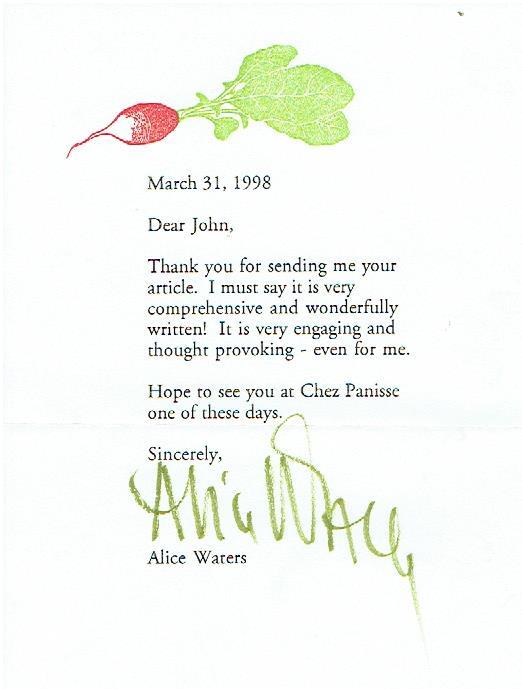![]()

THE GREEN GOURMETS
The Evolution of

The art form of our time, the final thirty years of the twentieth century, has been the preparation of food. What the sonnet was to Elizabeth's London, the Lied to Schubert's Vienna, the easel painting to Impressionist Pontoise, the movie to the Nineteen-Thirties: that, to many of us, is the meal.
Charles Shere
Two hundred years ago everybody made their own clothes. Nowadays we haven’t time to do that—we go out and buy our clothes. Nobody makes their own clothes unless it’s their hobby. The same thing will happen with food: I estimate that in about 50 years time dinner will be something people will go out and buy, and nobody will cook, unless it’s their hobby. We in the food industry are working towards that.
Food industry spokesman
BETWEEN these mutually reflective quotations, both dating from the mid 1990s, lies the progressive marginalizing of yet another essential human activity. Charles Shere reaffirms the importance of food as both craft and art; but to the modern mass mind these activities are synonymous with “hobby”, mere pastimes that may be taken up or put down as the wind blows. James Joyce and the Joyce Society—bubbling stream and stagnant pond—flow indivisibly together. Artists who resist being thus assimilated and insist on the inherent value of their work are regarded as elitist and egoistic.
Mental and physical activity are no longer essential to survival, and so vast areas of our brains have become derelict and open to invasion, the prey to virtual realities which take over our biological computers in order to store trivial data and shuffle their permutations. Since the necessary securities of food, clothing and shelter require no effort on our part except their purchase, most of our synapses and muscles remain dormant. Food has been the last to go: some new apartments are built without kitchens, and the skyrocketing sales of takeaways at fast-food outlets could soon make even cook-chill meals seem old-fashioned, since they must be taken home and microwaved, perhaps even served forth at an obsolescent dining table.
The cooking of real food from primary ingredients has been reduced to a spectator sport. TV voyeurs, who used to watch Jane Fonda working up a sweat, may now savor the balletic flourishes of celebrity chefs whose cookbooks erupt with gastronomic pornography—pages of seductive photos offering succulent dishes that the viewers will never taste unless they visit a bordel de cuisine, at which, for a price, skilled professionals are prepared to indulge their wildest fantasies.
Even most “real” foods are an illusion. Agri-business has shrunk crop diversity, so that fruits, vegetables and animals come from a contracting range of species which look and taste more or less the same; i.e., of nothing in particular. Blemish-free appearance and long shelf-life are paramount. Vast expanses of identical products are grown in consolidated country-sized farms under world-monopolist ownership where, both protected and fed by chemicals, these inedible clones of the animal and vegetable kingdoms are genetically manipulated into ever more anonymous travesties.
Under the guise of “giving the public what it wants”, the supra-national food firms are wiping out the last vestiges of indigenous food cultures and creating successive generations of addicts to sugar, fat and salt in escalating quantities. Some happy eaters may find their way out of this death-trap and, if they have time, money and transportation, seek out the best sources of organically-grown ingredients, and even plant their own gardens. But at the bottom of the economic ladder, the people who are most in need of good cheap nourishment are the ones to whom it is most effectively denied. The poorer the neighborhood, the more likely that the local shops will sell only the worst junk at the most inflated prices. As for planting their own produce, even if it were possible to grow unpolluted food in such an environment, slum property is far too valuable for growing anything except money.
 NEVERTHELESS, some chefs are attempting, against all the odds, to restore good food to its rightful place as the foundation of life. If they come across as pre-Raphaelites of the kitchen, it is because the media apply an artsy-craftsy façade to anything inventive that’s done with the hands. Alice Waters is one of their icons: she is the principal founder and public persona of Chez Panisse, a world-class restaurant in Berkeley, California that the “lifestyle” pages love to promote as the thinking-class eatery serving eggs to eggheads and caviar to the general.
NEVERTHELESS, some chefs are attempting, against all the odds, to restore good food to its rightful place as the foundation of life. If they come across as pre-Raphaelites of the kitchen, it is because the media apply an artsy-craftsy façade to anything inventive that’s done with the hands. Alice Waters is one of their icons: she is the principal founder and public persona of Chez Panisse, a world-class restaurant in Berkeley, California that the “lifestyle” pages love to promote as the thinking-class eatery serving eggs to eggheads and caviar to the general.
But the media image is not the restaurant’s reality. Behind the scenes, Alice's encouragement of small-scale local food producers has helped to bring about a renaissance of organic market gardening all over California. Her ultimate goal is not merely to improve the diet of the middle classes, but to restore real food to those who can no longer afford it—or even identify it! In a commencement address at Mills College, she summed up her guiding principles:
If you choose to eat mass-produced fast food, you are supporting a network of supply and demand that is destroying local communities and traditional ways of life all over the world—a system that replaces self-sufficiency with dependence. And you are supporting a method of agriculture that is ecologically unsound—that depletes the soil and leaves harmful chemical residues in our food.
But if you decide to eat fresh food in season—and only in season—that is locally grown by farmers who take care of the earth, then you are contributing to the health and stability of local agriculture and local communities.
ALICE Waters did not just climb onto the ecological bandwagon. Her political and gastronomic apprenticeship began in 1964 when she escaped from the University of California’s sorority heaven at Santa Barbara to UC Berkeley and, during the summer prior to beginning her studies, enrolled for a credit-earning tour of Europe. She never got beyond France, whose restaurants were for her the equivalent of the Paris literary cafés for America’s inter bellum writers. Their gastronomic delights captured her attention, and a single dinner in Brittany changed her attitude to food and ultimately her life. “I’ve remembered this dinner a thousand times,” she says. “The chef, a woman, announced the menu: cured ham and melon, trout with almonds, and raspberry tart. The trout had just come from the stream and the raspberries from the garden. It was this immediacy that made those dishes so special.” At the end of the meal, the chef received a standing ovation.
I can recall walking down the Rue Mouffetard in 1965, my first year in Paris [she said in a New Yorker interview]. I was a girl from New Jersey who'd grown up on frozen food, and to see the baskets and baskets of greens, so many shades of green and red! I walked up and down the street, my eyes unbelieving. I had never tasted an oyster. I went through Normandy, eating eighteen at a time and drinking apple cider, and it was so wonderful that I was just carried away, and I would fall asleep by the roadside. When I got back to Berkeley, I thought of opening a crêperie, and I tried to import some of the cider and found out that there was alcohol in it. That was why I kept passing out! I thought it was just the oysters and the apple juice and France.
Alice returned to Berkeley just in time for the Free Speech Movement, which was the beginning of her political education. She simultaneously joined the Movement and attempted to recreate the food she had experienced in France, using Elizabeth David's French Country Cooking as her guide. It was not long before she was feeding crowds of fellow-campaigners on fare as fresh and invigorating as their new-found principles.
By 1967 her dining room had become known as “ Alice's restaurant”.
Coincidentally, another Alice was serving real food on the other side of the continent in Stockbridge, Massachusetts (where flowed Charles Ives’ beloved Housatonic River). Alice Brock was inspired by her childhood summer experiences in Provincetown at Ciro and Sal’s, an Italian restaurant begun out of nothing in 1953 by  two penniless artists. The chef, artist Sal Del Deo [left], opened his own highly respected restaurant, Sal’s Place, at the other end of town in 1962, in accordance with the same ambitious principles of respect for staff, ingredients, diners and the planet’s ecology that Alice Waters would later espouse and amplify. Meanwhile, Alice Brock created a lunch-counter-culture she called The Back Room, with old-fashioned home cooking and home-baked bread, which she ran “as an act of love”. After it closed down it passed into mythology as Alice’s Restaurant, first in the Arlo Guthrie song and then in the Arthur Penn film in 1969. [References to the heroine of Lewis Carroll’s proto-psychedelic fantasies were widespread throughout the 60s.] Alice Brock ultimately retired to Provincetown, where even notorious celebrities could be swallowed up in its chaotic eccentricity, and at last account was still cooking there for charity events.
two penniless artists. The chef, artist Sal Del Deo [left], opened his own highly respected restaurant, Sal’s Place, at the other end of town in 1962, in accordance with the same ambitious principles of respect for staff, ingredients, diners and the planet’s ecology that Alice Waters would later espouse and amplify. Meanwhile, Alice Brock created a lunch-counter-culture she called The Back Room, with old-fashioned home cooking and home-baked bread, which she ran “as an act of love”. After it closed down it passed into mythology as Alice’s Restaurant, first in the Arlo Guthrie song and then in the Arthur Penn film in 1969. [References to the heroine of Lewis Carroll’s proto-psychedelic fantasies were widespread throughout the 60s.] Alice Brock ultimately retired to Provincetown, where even notorious celebrities could be swallowed up in its chaotic eccentricity, and at last account was still cooking there for charity events.
The two Alices were brought together in 2000 in Women of Taste: A Collaboration Celebrating Quilt Artists and Chefs, at the Oakland Museum of California.
During this time, Alice Waters was living with David Lance Goines, already a talented artist and printer, who would help to create the restaurant’s distinctive art nouveau-related graphic style. They met when Alice was press liaison for the Robert Scheer for Congress campaign in 1966. When he was defeated, she says, “I was so crushed, and I thought, I'm just going to start my own world.” Years later David was to write the definitive history of Berkeley’s Free Speech Movement. If you read this meticulously documented first-hand report by an active participant, you will learn what you need to know in order to understand—even to experience vicariously— Berkeley in the mid-60s. (There's a laid-back school of thought which maintains that, if you remember the 60s, you weren't there. Goines refutes it.)
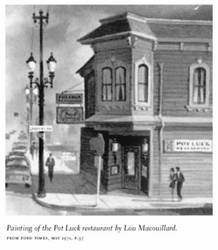 Berkeley was close enough to San Francisco to share its long-standing love of international cuisine coupled to radical politics. In the early 1950s Ed Brown, a self-taught chef and son of a well-to-do business man from Marin County, opened the Pot Luck in West Berkeley on San Pablo Avenue, near the bay. It soon became known to the cognoscienti. Jean Renoir was among its early patrons, no doubt related to the fact that his son Alain was a Professor of English at UC Berkeley. In the course of its ten-year history, it would anticipate certain aspects of Chez Panisse, including its eclectic cuisine, its equal-status hiring of minorities, and its Monday night fixed-price regional menus with appropriate wines. The final owner, Hank Rubin, has published a book recounting his youthful adventures with the Lincoln Brigade, Spain's Cause was Mine. As Charles Shere astutely observes, “Clearly there’s a synthesis of desire for justice, awareness of region or place, and an urge to nourish that runs like a thread through certain
Berkeley was close enough to San Francisco to share its long-standing love of international cuisine coupled to radical politics. In the early 1950s Ed Brown, a self-taught chef and son of a well-to-do business man from Marin County, opened the Pot Luck in West Berkeley on San Pablo Avenue, near the bay. It soon became known to the cognoscienti. Jean Renoir was among its early patrons, no doubt related to the fact that his son Alain was a Professor of English at UC Berkeley. In the course of its ten-year history, it would anticipate certain aspects of Chez Panisse, including its eclectic cuisine, its equal-status hiring of minorities, and its Monday night fixed-price regional menus with appropriate wines. The final owner, Hank Rubin, has published a book recounting his youthful adventures with the Lincoln Brigade, Spain's Cause was Mine. As Charles Shere astutely observes, “Clearly there’s a synthesis of desire for justice, awareness of region or place, and an urge to nourish that runs like a thread through certain 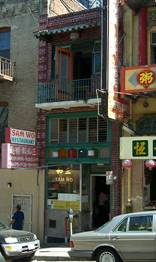 lives.”
lives.”
In 1963, Doris Muscatine (wife of Charles Muscatine, a non-signer of the University of California loyalty oath in 1950 and later a strong faculty supporter of the FSM) published A Cook’s Tour of San Francisco: the best restaurants and their recipes, which, together with the gathering places of the rich, featured family-style Basque restaurants such as the Hotel de France and Des Alpes; the homely Italian North Beach pasta parlor, Sorrento; and the unique, even surreal Chinese jook house, Sam Wo [right], whose raw fish salad with cilantro (coriander), Japanese scallions, preserved cucumbers, sweet & sour ginger, and crisp fried noodles anticipated the cornucopia of curious combinations at the cutting edge of the Pacific Rim. (Its notorious head waiter, Edsel Ford Fong, was immortalized by SF Chronicle columnist Herb Caen.).
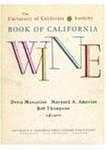
Twenty years later, Doris Muscatine would be the principal editor of The Book of California Wine, a 600-page history of viticulture in California beginning with the Spaniards in the 18th century. In her prefatory comments to a short chapter by Alice Waters, she identifies Chez Panisse as “a celebration of the quality and freshness of local products”.
-0-
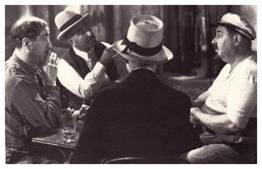 IT was not until 1971 that Chez Panisse found an identity and a permanent home. Alice took its name from the trilogy of Marseilles-based films [right] by Marcel Pagnol, whose milieu had come to exemplify for her the ideal community and would serve as an inspiration for her own extended family. The sailmaker Panisse was adopted as the restaurant's eponymous patron.
IT was not until 1971 that Chez Panisse found an identity and a permanent home. Alice took its name from the trilogy of Marseilles-based films [right] by Marcel Pagnol, whose milieu had come to exemplify for her the ideal community and would serve as an inspiration for her own extended family. The sailmaker Panisse was adopted as the restaurant's eponymous patron.
A house on north Shattuck Avenue came up for sale and was acquired by means of a ten-thousand-dollar loan from a sympathetic friend. It was across the street from the Co-op, itself a Berkeley institution which, after a successful quarter-century, would succumb to the temptation which Alice has steadfastly resisted—ambitious over-expansion. Though finished in stucco, it was gradually modified in ways which would in effect bring it into closer harmony with the work of Bernard Maybeck, the great Berkeley architect from the turn of the century who was championed by Charles Keeler in his highly influential book, The Simple Home. Maybeck and Keeler between them gave North Berkeley its abiding architectural character by establishing a tradition of natural, unpainted redwood, in which the houses looked much as though the trees themselves had decided to grow in new and interesting ways.
 Some alterations to Chez Panisse were carried out in the mid 70s by Kip Mesirow using Japanese carpenters’ tools and techniques; he was also influenced by the Scottish architect Charles Rennie Macintosh, whose buildings are reminiscent of Maybeck, although, like traditional Japanese architecture, more austerely geometrical. David Goines’ jacket illustration [left] for TheChezPanisse Menu Cookbook in 1984, picturing the restaurant’s façade, echoes Jugendstil (whose artists adopted many of Macintosh’s stylistic features and lionized him when he visited Vienna) and features a decorated porch which could have come from the drawing board of Maybeck himself.
Some alterations to Chez Panisse were carried out in the mid 70s by Kip Mesirow using Japanese carpenters’ tools and techniques; he was also influenced by the Scottish architect Charles Rennie Macintosh, whose buildings are reminiscent of Maybeck, although, like traditional Japanese architecture, more austerely geometrical. David Goines’ jacket illustration [left] for TheChezPanisse Menu Cookbook in 1984, picturing the restaurant’s façade, echoes Jugendstil (whose artists adopted many of Macintosh’s stylistic features and lionized him when he visited Vienna) and features a decorated porch which could have come from the drawing board of Maybeck himself.
Strongly imbued with a sense of community, Alice gathered together a small group of friends who would divide the work and share the responsibility. The first chef was Victoria Kroyer, later to become a famous restaurateur and food authority in her own right under her married name, Victoria Wise. Lindsey Shere was the pastry chef and would remain so for over a quarter of a century. Her husband Charles, a composer and author who in the middle 60s was Music Director at Berkeley’s then avant-garde FM station KPFA, was also intimately involved and is still one of the restaurant’s directors.
Alice and her associates soon discovered that the principles by which they wished to run their restaurant necessitated basic changes in the food supply structure. Accordingly, they set about creating a network of suppliers—now over sixty—who would grow the food they wanted in accordance with organic principles. Precisely because Alice was both communitarian and not formally trained in the food industry, she enlisted the help of friends who were prepared to experiment with the growing of vegetables and herbs in their gardens and window boxes. “Ignorance,” says Alice, was “an important, if unwitting factor in allowing Chez Panisse to become what it is.”
Gradually 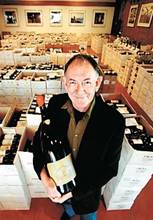 a small international circle of friends evolved which included some of the most inventive people in contemporary cuisine. Kermit Lynch [left], a self-described “recently defected hippie,” opened a wine shop on San Pablo in Berkeley in 1971. An avid amateur, he soon became an innovative wine importer, apparently being the first to discover and rectify the fact that wine shipped unrefrigerated through the Panama Canal would simmer merrily away to ruin. He soon became the restaurant’s principal supplier of French wines. The story of his discovery of the vineyards of France, Adventures on the Wine Route, has been translated into French and has become an oenological bible on both sides of the Atlantic.
a small international circle of friends evolved which included some of the most inventive people in contemporary cuisine. Kermit Lynch [left], a self-described “recently defected hippie,” opened a wine shop on San Pablo in Berkeley in 1971. An avid amateur, he soon became an innovative wine importer, apparently being the first to discover and rectify the fact that wine shipped unrefrigerated through the Panama Canal would simmer merrily away to ruin. He soon became the restaurant’s principal supplier of French wines. The story of his discovery of the vineyards of France, Adventures on the Wine Route, has been translated into French and has become an oenological bible on both sides of the Atlantic.
Like Alice, Kermit is a campaigner in his own right. “Alice and I both started our businesses around the same time,” he recalls. “She started cooking for an underground newspaper in San Francisco, and I was working for the Berkeley Barb—and there we were. Who could have imagined that we'd end up this way? It was very political what she was doing then, and it still is.”
Kermit has been instrumental in introducing the wines of Bandol into America, particularly those of Domaine Tempier, where Lucien Peyraud fought long and hard to raise the quality of the appellation by restoring the local Mourvèdre grape to at least fifty percent of the blend. Thanks to Kermit's 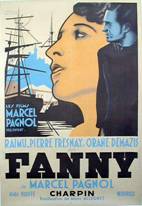 influence, this grape is also being grown in California, with excellent results; in France, he has helped to bring about a significant growth in the quantity and quality of organically grown wine.
influence, this grape is also being grown in California, with excellent results; in France, he has helped to bring about a significant growth in the quantity and quality of organically grown wine.
Next door to his salesroom/warehouse are two satellites of Chez Panisse—Café Fanny, a simple bar with some of the world’s best simple breakfasts, and the Acme Bakery, which supplies the restaurant’s many varieties of bread. The latter was founded in 1983 by the restaurant’s in-house baker, Steven Sullivan, who modeled his bread-making on Elizabeth David’s English Bread and Yeast Cookery, which had come out in America three years before.
 A fourth member of the circle, a close friend of the Peyrauds, was Richard Olney [left], one of the greatest American authorities on French cuisine. He met Kermit in 1974; that same year Lindsey Shere discovered his newly-published Simple French Food through a James Beard column and showed it to Alice. He became, along with Elizabeth David, an important culinary influence. Charles Shere has a photo of Lindsey, Alice, and Victoria consulting the book together.
A fourth member of the circle, a close friend of the Peyrauds, was Richard Olney [left], one of the greatest American authorities on French cuisine. He met Kermit in 1974; that same year Lindsey Shere discovered his newly-published Simple French Food through a James Beard column and showed it to Alice. He became, along with Elizabeth David, an important culinary influence. Charles Shere has a photo of Lindsey, Alice, and Victoria consulting the book together.
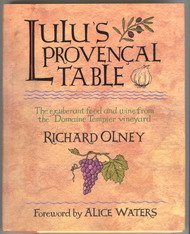 In 1994, the circle came together in Lulu’s Provençal Table: the exuberant food and wine from the Domaine Tempier vineyard, in which Olney presented the hearty, eminently practical provençal dishes of Madame Peyraud, with a warm introduction by Alice Waters, who had made the project happen. The photographs by Kermit Lynch’s wife, Gail Skoff, are permeated with the region’s deep orangy ochres. (When the UK edition came out, the excellent graphic design of the American edition was scrapped and the title changed to A Provençal Kitchen, in case the prospective buyer might think it the work of the 60s British pop star. Sigh.)
In 1994, the circle came together in Lulu’s Provençal Table: the exuberant food and wine from the Domaine Tempier vineyard, in which Olney presented the hearty, eminently practical provençal dishes of Madame Peyraud, with a warm introduction by Alice Waters, who had made the project happen. The photographs by Kermit Lynch’s wife, Gail Skoff, are permeated with the region’s deep orangy ochres. (When the UK edition came out, the excellent graphic design of the American edition was scrapped and the title changed to A Provençal Kitchen, in case the prospective buyer might think it the work of the 60s British pop star. Sigh.)
-0-
ALICE Waters has now achieved fame, though not fortune on the scale that celebrity chefs usually amass by endorsing the commercial foodstuffs they had once rejected—there are no Chez Panisse Brand frozen foods or bottled sauces. As the restaurant became busy, then fashionable and even legendary, Alice adhered to the principles with which she had begun. These include the demanding commitment to a constantly changing menu, in which the staff must improvise freely with the market’s seasonal offerings—and with each other—like experienced jazz musicians. (Theirs is a public performance, for the kitchen opens directly onto the dining room.) To avoid waste of food and money, the ground floor restaurant still serves a fixed menu at a fixed price. Monday night meals are about half the price of week-ends, thus giving impecunious gourmets a break.
Chez Panisse’s reputation with some food writers may fluctuate, but this is determined by the constantly shifting competitive league tables that keep them in business. Restaurants, and even entire cuisines, are manipulated in and out of fashion. “I hear that Chez Panisse isn’t what it used to be,” an American diner once said to me at Restaurant Jamin in Paris, as we put away an elegant but bland and unmemorable luncheon costing twice as much as if Alice had served it. Charles Shere is convinced that, not only is Chez Panisse “more passionate about its principles than it ever was”, but the quality of the food has steadily improved and is today better than ever, though it may not be so “breathtakingly entertaining”.
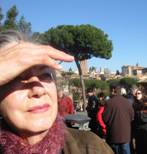 “So many people misunderstand it because of all the hype,” says Lindsey Shere [left] sadly. “They expect it to be like a three-star restaurant, and that’s not what we are or ever have been.” Nothing in my own experience over a quarter-century would contradict this; the restaurant, modestly distinguished in its decor, has always featured food rather than frippery.
“So many people misunderstand it because of all the hype,” says Lindsey Shere [left] sadly. “They expect it to be like a three-star restaurant, and that’s not what we are or ever have been.” Nothing in my own experience over a quarter-century would contradict this; the restaurant, modestly distinguished in its decor, has always featured food rather than frippery.
The media, however, have transformed the public image of Chez Panisse into something which Alice and her associates never intended. When a disgruntled food snob complained that he hadn’t been able to show off satisfactorily to a friend, Charles answered his letter in part:
The considerable attention given to Chez Panisse by the media has never been our idea; we don't go out looking for it. We feel it's unfortunate that people can't simply come to the restaurant for dinner and appreciate it on the two most important points: the ingredients, which we work very hard to find at their best, and the work that's expended on them in the kitchen, which we feel comes close to the best we can do. . . [T]hese two points are at the heart of our ambitions. . .
 As the turnover has risen, the most dramatic result has been the increase in the size of Alice's “family”. In fundamental opposition to the present fashion for “downsizing”, her total staff has grown to well over a hundred, twice that of a typical three-star French restaurant serving meals in sumptuous surroundings at more than double the price. Says Charles Shere [left], “I think that the most interesting thing about Chez Panisse is how it works as a business, how the management is responsible to its workers.” When a staff meeting was called to discuss a new pension scheme, a show of hands revealed that over half of those present (who were about eighty-five percent of the total) had been employed for more than seven years—and that didn't include the many volunteers, including Doris Muscatine, who help prepare for the annual Bastille Day Garlic Festival. To ensure that the restaurant will survive Alice’s eventual departure, shares are sold to employees. In today’s business climate, such loyalty from—and to—the staff is virtually unique.
As the turnover has risen, the most dramatic result has been the increase in the size of Alice's “family”. In fundamental opposition to the present fashion for “downsizing”, her total staff has grown to well over a hundred, twice that of a typical three-star French restaurant serving meals in sumptuous surroundings at more than double the price. Says Charles Shere [left], “I think that the most interesting thing about Chez Panisse is how it works as a business, how the management is responsible to its workers.” When a staff meeting was called to discuss a new pension scheme, a show of hands revealed that over half of those present (who were about eighty-five percent of the total) had been employed for more than seven years—and that didn't include the many volunteers, including Doris Muscatine, who help prepare for the annual Bastille Day Garlic Festival. To ensure that the restaurant will survive Alice’s eventual departure, shares are sold to employees. In today’s business climate, such loyalty from—and to—the staff is virtually unique.
PERHAPS Alice Waters’ lasting legacy will lie in the Chez Panisse Foundation, whose “mission is to build a healthier society by supporting cultural and educational programs that promote sustainable agriculture.” The most important projects thus far have been the Garden Project at the San Francisco County Jail, supplying prisoners and ex-prisoners with real jobs and the restaurant with produce; and, more recently, the Edible Schoolyard [right]. Such a project would be challenging enough in a 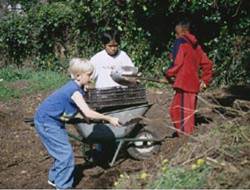 comfortable middle-class environment, but the Foundation chose to set it up in the near-by Martin Luther King Jr. Middle School. “When I saw . . . the graffiti on the windows and the burned-out lawn,” Alice says, “I thought it was abandoned. The cafeteria had been abandoned for fifteen years. Most of the kids didn’t eat breakfast or lunch. What I envisioned was a place where the kids could serve each other the lunch they’d grow.” The project has been so successful that the Foundation has been given asked to set up more edible gardens throughout Berkeley.
comfortable middle-class environment, but the Foundation chose to set it up in the near-by Martin Luther King Jr. Middle School. “When I saw . . . the graffiti on the windows and the burned-out lawn,” Alice says, “I thought it was abandoned. The cafeteria had been abandoned for fifteen years. Most of the kids didn’t eat breakfast or lunch. What I envisioned was a place where the kids could serve each other the lunch they’d grow.” The project has been so successful that the Foundation has been given asked to set up more edible gardens throughout Berkeley.
Thus Chez Panisse continues to demonstrate that good food and good ethics are ultimately interdependent. “The sensual pleasure of eating beautiful food from the garden brings with it the moral satisfaction of doing the right thing for the planet and for yourself,” Alice Waters asserts. Her final words to the graduating class at Mills College were:
Actions have consequences, and people acting responsibly can make a difference. I believe that how you eat, and how you choose your food, is an act which combines the political—your place in the world of other people—with the most intensely personal—the way you use your mind and your senses, together, for the gratification of your soul. It can change the way we treat each other, and it can change the world.
This is far from being a lost cause. Organizations such as Slow Food and Eurotoques have been formed in support of these very principles. Their motivation may appear to be primarily aesthetic, but artists and craftspersons, when they adhere unswervingly to qualitative principles in a quantitatively governed society, become, like Alice Waters, profoundly and ineluctably political.
-0-
Sources
My thanks to Charles Shere for most of my direct knowledge of Chez Panisse, and for his useful suggestions. I claim credit only for any errors or misinterpretations. It first appeared in the present form in Radical Poetics 2. An ealier shorter version was written for The Food Magazine.
Joanna Blythman, “Simple Pleasures” [Euro-Toques], The [ London] Guardian Weekend, July 18, 1998.
Marian Burros, “Alice Waters, Food Revolutionary”, The New York Times, August 14, 1996.
Chez Panisse Gala Edition, Food Section, Los Angeles Times, August 22, 1996.
Chez Panisse Web Site, http://www.chezpanisse.com
Sal and Josephine Del Deo, conversation and correspondence
David Lance Goines, The Free Speech Movement: coming of age in the 1960s, Berkeley CA, 10 Speed Press, 1993.
Adam Gopnik, “Annals of Gastronomy: The Millennial Restaurant”, The New Yorker, October 26 & November 2, 1998
Charles Keeler, The Simple Home (1904), reprinted Santa Barbara, Peregrine Smith, 1979.
Kermit Lynch, Adventures on the Wine Route, NY, Farrar, Strauss and Giroux, 1988.
Doris Muscatine, A Cook’s Tour of San Francisco: the best restaurants and their recipes, NY, Charles Scribner’s Sons, 1963.
Doris Muscatine et al, ed., Book of California Wine, Berkeley, UC Press/Sotheby, 1984.
Richard Olney, Lulu’s Provençal Table: the exuberant food and wine from the Domaine Tempier vineyard, NY, HarperCollins, 1994
Paul Rauber, “Conservation a la Carte”, Sierra, November/December 1994.
Joan Reardon, M.F.K.Fisher, Julia Child, and Alice Waters: celebrating the pleasures of the table. NY, Harmony Books, 1994.
Charles and Lindsey Shere, conversation and correspondence
©2002 John Whiting
December 2013 The BBC’s habitually excellent Food Programme, produced by Sheila Dillon, has devoted its half hour to a retrospective history of Chez Panisse, framed within a recent interview with Alice Waters and including sound clips from several previous programs. As Alice would wish, the focus is not on gourmet dining but on the social results of what we eat and where it comes from.
In fact, the program is so good and ties in so well with what I’ve written above that I’ve recorded it off the air and uploaded it into this website so that it will (I hope) be permanently available. You can listen to it HERE.
